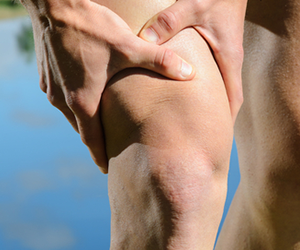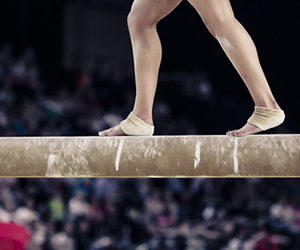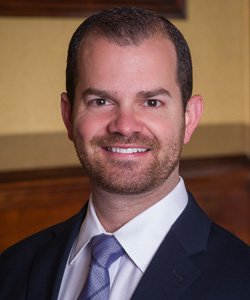Understanding and Treating an ACL Injury

The fear of an ACL injury is always on the mind of many athletes. ACL injuries are one of the most common knee injuries, and while athletes are at a higher risk for ACL injury, it can happen to anyone. The anterior cruciate ligament—or ACL—is one of four main ligaments that connect the bones of the knee joint together. The knee joint is comprised of the femur (thigh bone), tibia (shin bone) and patella (kneecap). The four main ligaments of the knee joint, including the ACL, hold these bones together and stabilize the knee.
The medial and lateral collateral ligaments (MCL and LCL) run along the sides of the knee, preventing it from bending in or out. The anterior and posterior cruciate ligaments (ACL and PCL) are located in the knee joint (ACL in front and PCL in back), preventing the tibia from sliding out in front of the femur, and from sliding backwards under the femur. Due to its location near the front of the knee, the ACL is more prone to sprains and tears caused by direct trauma or overextension of the ligament.
ACL injuries range in severity, and the severity of the injury will determine how to properly treat it. ACL injuries range from over stretched, to loosened, and near complete or complete tears. Damage to the ACL greatly affects mobility and strength of the knee, and treatment should be sought as soon as possible. (Medline Plus)
Symptoms
At the occurrence of injury, a popping noise and sensation can often be heard and felt, followed by the knee giving out. Other symptoms include:
- Pain and swelling
- Pain and discomfort when walking
- Inability to put weight on the knee
- Decreased range of motion (Ortho Info)
Risk Factors and Causes
ACL injury occurs most often in high demand athletic sports such as football, downhill skiing, gymnastics, and soccer. However, as ACL injuries are one of the most common knee injuries, it is common for non athletes to experience injury as well. Common causes of ACL injury include:
- Incorrect landing from a jump (like a ski jump)
- Rapid change of direction (such as during dribbling in soccer)
- Rapid stopping while running
- Direct hit to the knee (like a tackle in football)
Some individuals may be at a higher risk of experiencing an ACL injury. Women are at a higher risk than men, which is believed to be a result of anatomical differences. Athletes in high demand sports are also at a great risk of ACL injury. In addition, those who have experienced an ACL injury before are at a higher risk for repeat injury. (Ortho Info)

Non - Surgical Treatment
The decision between non-surgical and surgical treatment for ACL injuries depends on several factors including severity of injury, activity level of patient, age of patient. Partial tears and sprained ligaments may be able to avoid surgery and instead be treated through non-surgical methods such as strengthening physical therapy. Older patients or patients who lead more sedentary lifestyles may be able to avoid surgery if their lifestyle is not dependent on recovering full strength and range of motion of the knee. However, in young patients, those with active lifestyles, and athletes, surgery is typically the best option for severe ACL tears. (Ortho Info)
Surgical Treatment
Surgery is the best long term treatment for severe ACL injuries like partial or full tears. Surgical treatment along with proper rehabilitation and post op physical therapy, gives patients the highest chance of successfully returning to their previous active lifestyles or sport. Surgery for ACL tears does not typically involve an ACL repair by suturing the ligament back together, as repaired ACLs tend to fail over time.
Instead, surgeons will replace the torn ACL with a graft tendon, creating a new anterior cruciate ligament. Grafts are either autografts or allografts. Autografts are typically taken from the patient's own patellar tendon or hamstring tendon, the benefit of autografts is that the tendon is from the patient's own body and as such, will heal quicker. Some surgeons prefer allograft tendons taken from the body of a cadaver as it does not require the removal of the patient’s own tendon. (Sports Health)
If you’re an athlete, it’s important to seek proper training and coaching to avoid injury to your ACL. If you do experience a knee injury, cease activity and seek medical attention immediately. ACL injuries are often accompanied by injuries to other areas of the knee and knee joint, and it’s important you get a professional diagnosis of the problem as soon as possible. (Ortho Info)
In the event of an ACL sprain or tear, the highly trained orthopaedic specialists at MidAmerica Orthopaedics will get you on the road to recovery. From diagnosis, to surgery, and physical therapy, MidAmerica Othopaedics has each step of the treatment and recovery process covered.

Dr. Adam F. Meisel
Among our specialists qualified to treat ACL injuries is Dr. Adam F. Meisel, who specializes in sports medicine and tendon and ligament injuries. Dr. Meisel’s goal is to help his patients return to and maintain their active lifestyles through both operative and non operative treatments.
To schedule an appointment with MidAmerica Orthopedic sports medicine specialist, Dr. Adam F. Meisel, call (708) 237-7200. You can also request an appointment online.
MidAmerica Orthopaedics serves various areas such as Chicago, Palos Hills, Mokena, New Lenox, Oak Lawn, Burbank and more.

